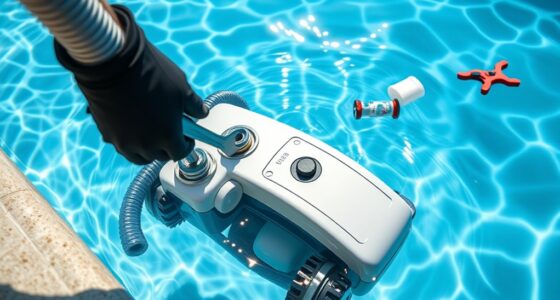To prevent suction loss in your pool cleaner, regularly inspect and clean your skimmer and pump baskets to avoid blockages. Keep hoses straight, check for leaks, and make certain all fittings are tight and in good condition. Maintain proper water levels and adjust the cleaner’s placement for maximum suction. Replace worn parts promptly and verify that seals are secure. For more tips, discover how every detail can help your pool cleaner perform effortlessly.
Key Takeaways
- Regularly inspect and clean skimmer baskets, hoses, seals, and fittings for debris, cracks, and wear to prevent obstructions.
- Ensure the pool water level is maintained at the skimmer opening or midpoint for optimal suction.
- Check and tighten all fittings, seals, and hoses to prevent leaks and maintain proper water flow.
- Replace worn or damaged components like seals, brushes, and hoses promptly to sustain suction efficiency.
- Conduct routine troubleshooting and adjustments to maintain proper alignment, water levels, and seal integrity.
Check and Clear the Skimmer and Pump Strainer Baskets

To prevent suction loss, you should regularly check and clear the skimmer and pump strainer baskets. These baskets trap debris that can clog the system and reduce suction. Start by removing the skimmer basket and inspecting it for leaves, dirt, and other debris. Rinse it thoroughly with water to guarantee it’s clear. Next, check the pump strainer — it’s often located near the pump itself. Remove the strainer cover and clean out any obstructions, making sure the basket inside is free of debris. A clean skimmer basket and pump strainer allow water to flow smoothly, maintaining ideal suction and preventing the pool cleaner from losing its grip. Regular maintenance of these components keeps your pool system working efficiently and reduces the risk of suction issues. Additionally, ensuring that the pump and filter systems are functioning properly can help prevent system failure, and maintain consistent suction power. Properly functioning pool filtration systems are essential for optimal performance. Checking the filter media regularly can also enhance overall system efficiency and prevent blockages. Implementing routine inspections can further safeguard against clogged filters that impair water flow, especially in systems with complex filtration equipment that require detailed upkeep.
Inspect and Maintain the Pool Hose and Connections
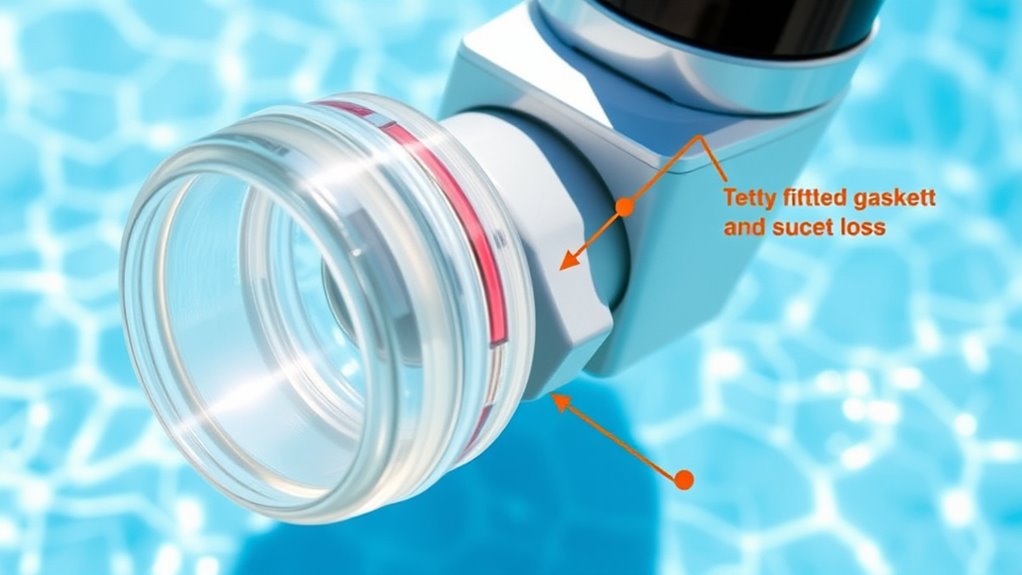
Regularly check your pool hose and connections for leaks, as even small cracks can cause suction loss. Make sure fittings are tightened properly to prevent air leaks that reduce efficiency. If you notice worn or damaged parts, replace them promptly to keep your cleaner working smoothly. Incorporating grocery savings strategies can also help you allocate funds for necessary repairs and maintenance. Additionally, understanding risk management principles can guide you in prioritizing repairs that prevent further damage and expenses. Staying informed about AI technology advancements can also inspire innovative solutions for maintaining your pool equipment more effectively. Being aware of home maintenance best practices ensures you stay proactive in keeping your pool clean and functional.
Check for Leaks Regularly
Since leaks in the pool hose or connections can cause suction loss, it’s vital to check them frequently. Regular inspections help identify cracks, loose fittings, or worn-out seals that could disrupt your cleaner’s performance. Always guarantee your pool chemistry is balanced, as imbalances can weaken hoses and fittings over time. Proper inspection techniques can help detect issues early before they lead to more significant problems. Conducting routine maintenance is essential to maintain optimal operation and prevent unexpected failures. Additionally, inspecting for corrosion or mineral buildup can prolong the lifespan of your equipment and ensure consistent suction. Being aware of common issues during inspections can help you address problems promptly and maintain efficient operation. Follow safety precautions during inspections to avoid accidents. Use the table below to guide your checks:
| Issue | Possible Cause | Solution |
|---|---|---|
| Loss of suction | Leaking hose or fittings | Tighten or replace connections |
| Cracks or tears | Wear and tear | Replace damaged hoses |
| Loose fittings | Improper installation | Re-secure fittings |
Keeping these areas in check ensures your pool cleaner stays efficient and safe. Regular maintenance and understanding your pool system can help prevent larger issues down the line.
Tighten Fittings Properly
Ensuring your pool hose fittings are tightly secured is essential for maintaining proper suction. Proper fitting tightness prevents air leaks that can cause suction loss, making your cleaner less effective. Check all connections regularly, ensuring they’re snug without over-tightening, which could damage the fittings. Loose fittings compromise seal integrity, allowing air to enter the system and reduce suction power. When inspecting, look for any signs of wear or cracks in the fittings and replace if necessary. Maintaining a secure fit guarantees ideal seal integrity, so your pool cleaner can operate efficiently. Additionally, using durable materials for fittings can help prevent leaks and extend the lifespan of your equipment. Choosing high-quality pool fittings made from corrosion-resistant materials can further enhance the effectiveness of your maintenance routine. Regularly inspect connections for tightness and wear helps catch potential issues early and prevents suction problems. Remember, a simple tightening step can resolve many suction issues before they become more serious problems. Proper fitting tightness is a key factor in preventing suction loss. Consistent attention to fitting tightness keeps your cleaning system running smoothly and effectively.
Replace Worn Components
Over time, wear and tear can compromise your pool hose and connections, leading to decreased suction and cleaning efficiency. Regularly inspecting these components helps maintain ideal pool cleaner longevity and prevents suction loss. Look for cracks, holes, or brittle spots on the hose, and replace any damaged parts immediately. Loose or worn fittings can also reduce suction; tighten or upgrade these components as needed. Upgrading to newer, more durable hoses and fittings can improve overall performance and extend your cleaner’s lifespan. Don’t wait until your cleaner stalls—proactive replacement of worn components ensures consistent suction and effective cleaning. Maintaining your pool hose and connections is a simple step that preserves efficiency and saves you money in the long run.
Ensure Proper Placement of the Pool Cleaner
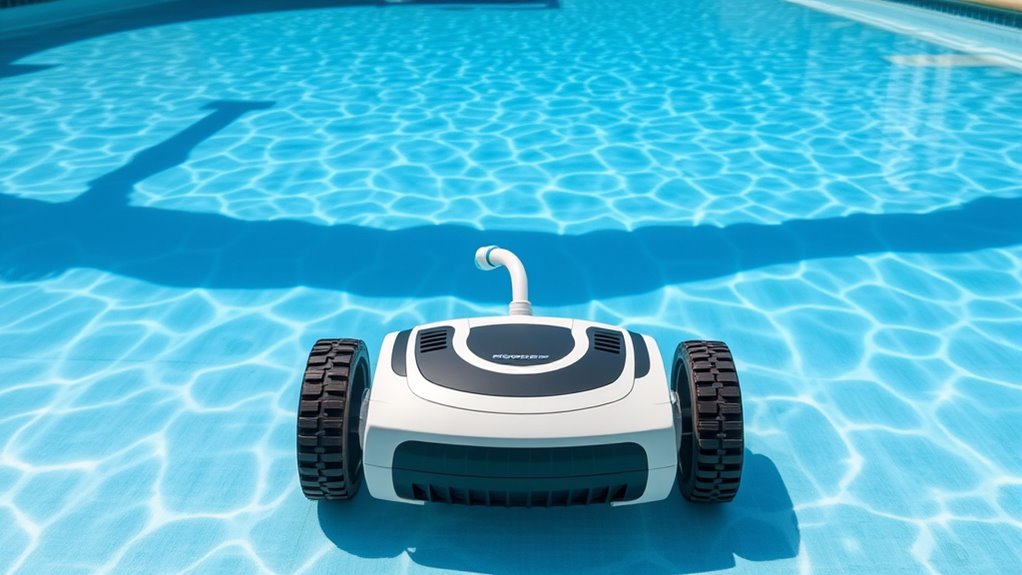
Proper placement of your pool cleaner is essential to prevent suction loss and guarantee effective cleaning. Correct alignment ensures the suction port is positioned properly, maintaining consistent suction power. To achieve this:
- Check the pool cleaner’s alignment to ensure it’s not crooked or tilted, which can disrupt suction.
- Position the suction port correctly, making sure it’s directed toward the area you want cleaned, not blocked by debris or the pool wall.
- Keep the cleaner’s hose straight and free of kinks to allow smooth water flow and maintain proper suction.
- Regular maintenance and inspection of the system can help identify potential issues with refrigerant management that might affect the cleaner’s performance.
- Ensuring the power output of your pool cleaner matches the pool size can help maintain optimal suction and cleaning efficiency.
Regularly Examine the Pool Cleaner for Damage or Wear

Regularly inspecting your pool cleaner for damage or wear is essential to maintaining peak suction and cleaning performance. Consistent damage inspection helps catch issues early, preventing costly repairs and ensuring your cleaner works efficiently. Look for cracks, tears, or worn spots on hoses, brushes, and seals. Damaged parts can cause leaks, reducing suction power and compromising your pool cleaner maintenance routine. Keep an eye out for loose connections or unusual noises, which signal potential problems. Use this table to assess your cleaner’s condition and evoke a sense of pride in your upkeep:
| Area to Check | Signs of Damage or Wear |
|---|---|
| Hoses and Seals | Cracks, leaks, or stiffness |
| Brushes and Skirts | Worn bristles, tears, or gaps |
| Connections | Loose fittings or corrosion |
Regular damage inspection keeps your cleaner running smoothly.
Adjust the Pool Cleaner’s Skirt or Brush for a Tight Seal
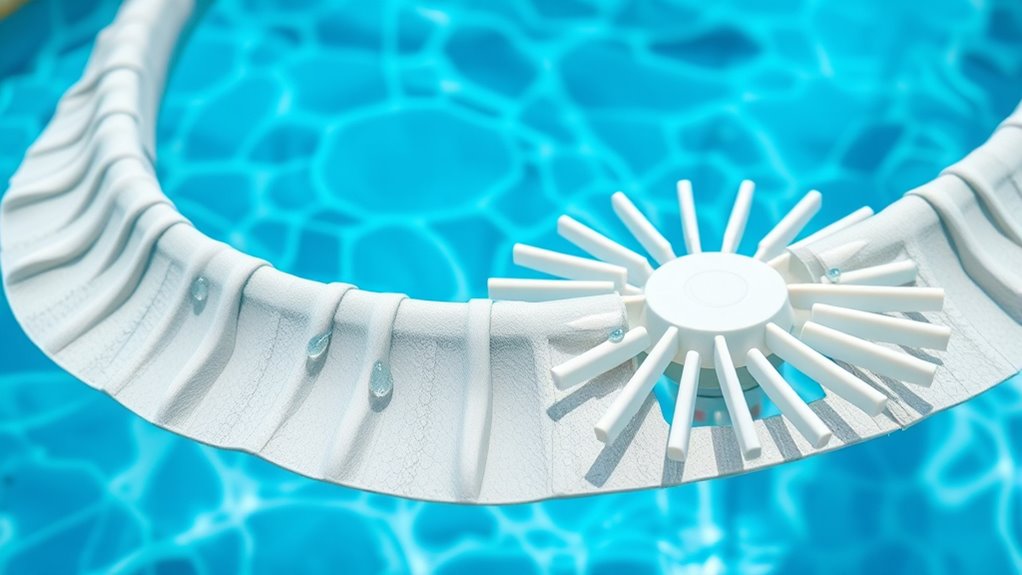
If your pool cleaner isn’t maintaining a tight seal, adjusting the skirt or brush can considerably improve suction. Proper skirt adjustment ensures a snug fit against the pool surface, preventing air leaks. Similarly, check the brush sealing to confirm it’s secure and intact. Here are steps to optimize your seal:
- Inspect the skirt for tears or debris, then perform a skirt adjustment by repositioning or replacing it if needed.
- Clean the brush and verify it’s properly seated, ensuring the sealing edges are tight.
- Test the seal by running the cleaner and observing for air leaks; re-adjust the skirt or brush sealing if necessary.
Making these adjustments helps maintain strong suction and improves your pool cleaner’s efficiency.
Manage Water Level for Optimal Suction
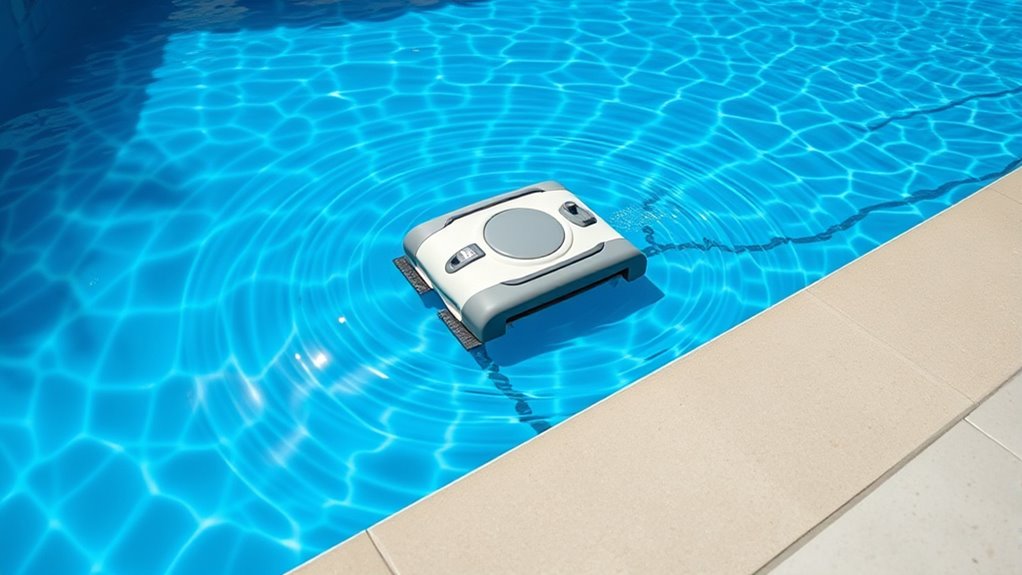
Keeping the water level in your pool just right is key to maintaining strong suction. If it’s too low or too high, your cleaner won’t work efficiently. Make sure to adjust the water levels regularly to keep your pool cleaner running smoothly.
Maintain Proper Water Height
Maintaining the correct water level in your pool is essential to guarantee your cleaner operates with ideal suction. If the water is too low, water pressure drops, reducing suction and increasing debris buildup around the cleaner. To keep your pool functioning properly:
- Regularly check the water height and add water if it drops below the skimmer opening.
- Avoid overfilling, which can cause the cleaner to lose suction and float.
- Clear debris from skimmers and skimmer baskets to prevent blockages that affect water pressure.
Proper water level helps sustain excellent water pressure, ensuring your cleaner works efficiently without suction loss. Staying vigilant about water height prevents debris buildup and keeps your pool cleaner running smoothly.
Adjust Pool Water Levels
To guarantee your pool cleaner maintains strong suction, you need to manage the water level actively. The water level directly impacts suction efficiency, so keeping it within the recommended range is essential. If the water is too low, the cleaner may lose suction and stop working effectively. Conversely, if it’s too high, the cleaner might struggle to move properly, reducing its cleaning power. Regularly check the water level and adjust as needed, especially after heavy use or rain. For ideal results, maintain the water at the midpoint of the skimmer opening. This ensures the cleaner’s suction remains consistent, preventing loss and maximizing cleaning performance. Proper water level management is a simple yet vital step in maintaining your pool cleaner’s efficiency.
Troubleshoot and Replace Faulty Components
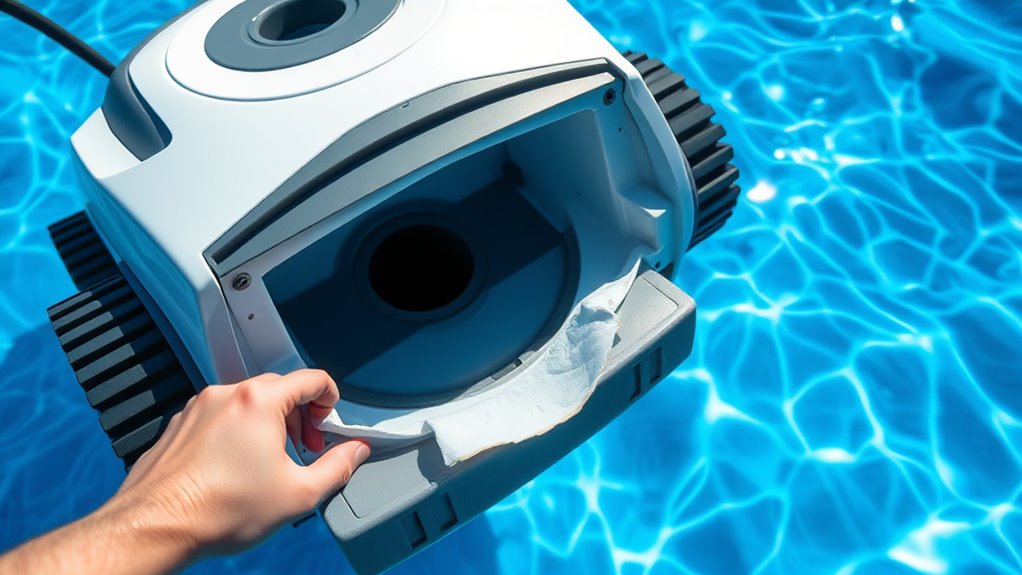
When you notice a sudden drop in your pool cleaner’s suction, it’s essential to troubleshoot and identify faulty components quickly. Start by inspecting the vacuum motor; if it’s not running smoothly or makes unusual noises, it might be faulty and need replacing. Next, check the control panel for error codes or malfunctions that could affect operation. Lastly, examine hoses and connections for leaks or blockages, which can reduce suction.
- Test the vacuum motor’s function and replace if it’s failing.
- Reset or repair the control panel to ensure proper signals.
- Inspect all hoses and seals for cracks or obstructions.
Frequently Asked Questions
How Often Should I Perform Routine Pool Cleaner Maintenance?
You should perform routine pool cleaner maintenance every one to two months. Check your filter replacement regularly to make certain it’s not clogged, which can reduce suction. Also, inspect the hose for cracks or blockages and clean or replace it if needed. Keeping up with these tasks helps your cleaner operate efficiently, preventing suction loss and extending its lifespan. Regular maintenance makes pool cleaning easier and more effective.
Can Debris in the Pool Affect Suction Performance?
Like a knight guarding a treasure, debris can threaten your pool cleaner’s suction. Yes, debris accumulation and filter clogging directly influence suction performance, making your cleaner less effective. When debris piles up, it blocks water flow, reducing suction power. Regularly cleaning the filter and removing debris guarantees your pool cleaner functions smoothly, keeping your pool pristine. Don’t let debris win the battle—stay vigilant and maintain your cleaner’s efficiency.
What Signs Indicate a Damaged Pool Cleaner Component?
If your pool cleaner isn’t working properly, look for signs of damage. You might notice decreased pump pressure, which indicates issues in the system. Hose leaks can also cause problems, leading to reduced suction. Inspect hoses and connections regularly for cracks or tears. If you see these signs, it’s time to repair or replace the damaged component to restore peak performance and prevent further damage.
Is It Necessary to Recalibrate the Cleaner After Maintenance?
They say, “A stitch in time saves nine,” and that’s true for your pool cleaner too. After maintenance, recalibrating is vital because it guarantees proper suction and cleaning efficiency. Calibration importance increases with regular maintenance frequency, preventing issues like suction loss. While it may seem like an extra step, recalibrating keeps your cleaner working smoothly and prolongs its lifespan, making your pool cleaning hassle-free.
How Do Temperature Changes Impact Pool Cleaner Suction?
Temperature fluctuations can considerably impact your pool cleaner’s suction efficiency. When water warms, it may cause parts to expand slightly, affecting seals and connections, which can reduce suction. Conversely, colder water can make materials contract, potentially creating leaks or loose fittings. To keep your cleaner functioning at its best, regularly check and tighten connections, and be aware of how temperature changes might alter its performance. Maintaining these adjustments ensures consistent suction efficiency.
Conclusion
By keeping your pool cleaner’s pathways clear and its parts in top shape, you’re fundamentally guiding a steady stream of water through a well-oiled machine. Think of your pool as a symphony, where each note—every connection and seal—must harmonize perfectly. When you maintain and troubleshoot diligently, you prevent suction loss from sneaking in like a silent thief. With these tips, you’ll keep your pool cleaner running smoothly, transforming your pool into a sparkling oasis with effortless grace.




